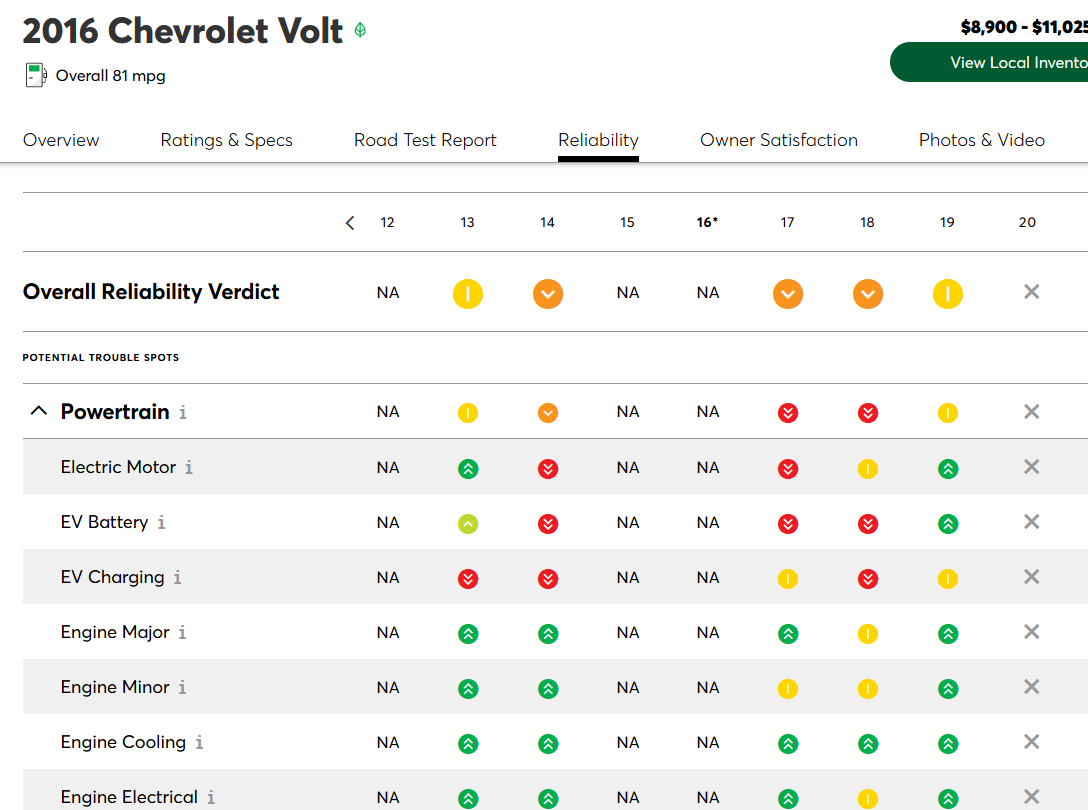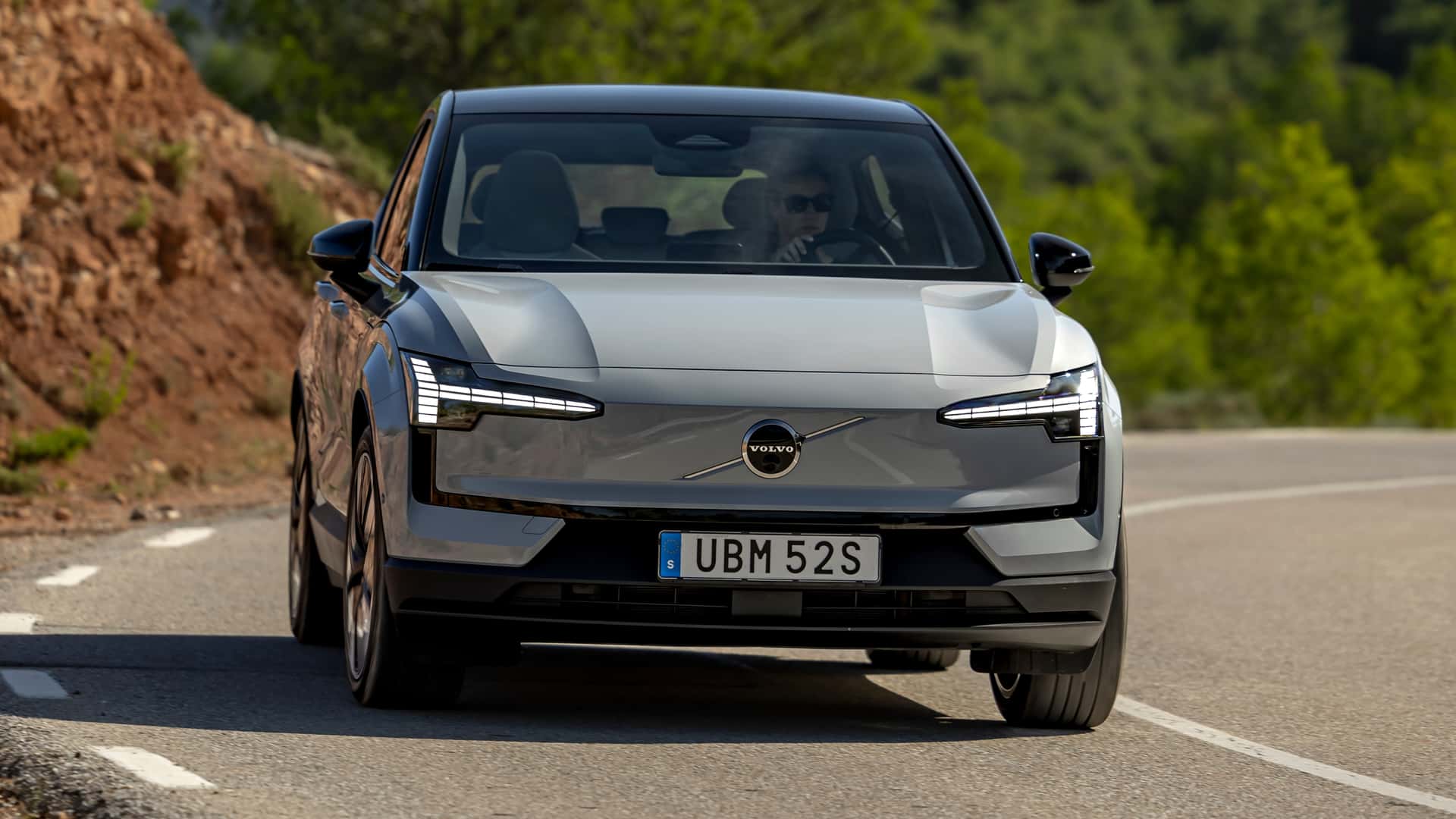Data from thousands of EVs shows the average daily driving distance is a small percentage of the EPA range of most EVs.
For years, range anxiety has been a major barrier to wider EV adoption in the U.S. It’s a common fear: imagine being in the middle of nowhere, with 5% juice remaining in your battery, and nowhere to charge. A nightmare nobody ever wants to experience, right? But a new study proves that in the real world, that’s a highly improbable scenario.
After analyzing information from 18,000 EVs across all 50 U.S. states, battery health and data start-up Recurrent found something we sort of knew but took for granted. The average distance Americans cover daily constitutes only a small percentage of what EVs are capable of covering thanks to modern-day battery and powertrain systems.
The study revealed that depending on the state, the average daily driving distance for EVs was between 20 and 45 miles, consuming only 8 to 16% of a battery’s EPA-rated range. Most EVs on sale today in the U.S. offer around 250 miles of range, and many models are capable of covering over 300 miles.
I don’t need a scientific study to know that most days I’d need my car for a significantly lower driving distance than the few long-range outliers.
The problem isn’t a logistical of “Wow! Turns out I can commute with an EV because I don’t drive 400 km to work each day! Thank you Mr. Scientist!” but a financial one. The large majority of people can afford one car, if any, and this one car has to work for everything. Do you think people are happy investing in a 20k or more EV when they still have to rent a car to visit their familiy over holidays?
If it’s just for the sake of driving around town daily, EVs need to get significantly cheaper to be interesting for people with normal incomes.
Basically this. My commute is a little over 40 miles. If I got a leaf (which my dad used to have, so I know it well), I could get there and back. Unless I had to make an additional stop on the way home. Or run a significant errant on my lunch break. Then it might get squiffy.
But, okay, maybe I have a spouse I can ask to run errands and stuff for me. Then I just have to worry about when its hot or cold enough I need to run the AC or heater, in which case my range goes down to 60 miles. Good thing that only happens 11 months out of the year.
Edit: I also live in an apartment. I’m sure nobody will have an issue with me throwing a cable out of my bedroom window on the second floor and snaking it across the parking lot to my car.
Don’t forget you’ll lose like 1.5% of your overall battery life like every year.
Then, don’t worry. If the battery needs replaced it will only cost you…$8,000.
My battery got replaced at 5 years old due to a warranty issue
Before that I had lost a grand total of 1.6% battery capacity, and I charged almost exclusively through fast chargers
Battery degradation is massively overexaggerated
You also literally just said you had to replace your battery, the capacity readouts the vehicles give are often not correct. It’s literally impossible for a car or phone or anything that uses rechargeable batteries to know true capacity loss without a full discharge (ie car stop/phone shuts off ect.) and is charged to 100% capacity. Unless you do that capacity lost can only be an estimate based on expectation of degradation and total usage with an added curve on boltage levels.
You had it replaced at 5 years under warranty, so it had less than 100k miles on it and you were 3 years away from having to pay out of pocket even if you managed to go the 8 year warranty without hitting the 100k mark. Your car had a $12,000 failure after just 5 years (or dangerous issue that had to warrant a new battery) but you’re defending the thing because it got replaced under a federally required warranty. Good job, my guy.
If we built good regional/national/international transit, a lot of the longer range issues could be fixed. Some people may still need more range/more storage but high speed rail could get people farther more effeciently than their EVs and be suitable for many trips.
If we had better infrastructure, there would be fewer commutes using cars.
US transit that could efficiently take you to every city you may need to go to in the US would be absolutely insane to try and pull off. It’s great for countries the size of one or two of our states, but try to imagine what a transit network to get you from Clarksville Iowa to Clinton Missouri would actually look like. It would need to be insane.
But it’s not that insane: the key is to use each transportation for where it’s good, rather than make the same mistake we did with cars and apply it everywhere.
- we could connect probably 80% of the US population with high speed rail at a similar effort to other developed countries
- accept that personal vehicles are the best choice for a small portion of our population
Currently one of the reasons we’re stuck is one side expecting to always need a car and the other wanting to take their cars. But there’s a medium where we could all be happy, where most trips are transit and no one is left without options
How different is that really from a road network?
A road network has a much lower initial investment cost and can just sit there even if it’s underutilized, accruing comparatively very little in terms of ongoing maintenance costs, with no one needing to hyperventilate constantly about running a passenger service with enough asses in seats with sufficient regularity to recoup the costs. It can also go to a lot more destinations, and importantly can do so for mixed uses.
You could build train rails to the moon and back if you felt like it, but they’d decay quickly and it is statistically certain nobody would be riding on them to most places to justify paying for the upkeep, let alone the initial installation. This is not so with rural roads. There are also massive planning and logistical challenges you need to take into account for rail, mostly due to the fact that trains are crap at climbing inclines which is not an issue you’ll face (as much) with roads. This is why roadgoing vehicles have tires (well, one reason). You’ll be flattening mountaintops and boring tunnels and building bridges all over the place. It’s not cost or environmentally effective for little-utilized routes.
No matter how well the mass transport system gets, you’ll still have to have the road network. Every business will have to get stuff delivered by large truck. Every housing area will have to get streets, and you also can’t eliminate highways. You could only potentially reduce how wide they are in some areas.
China has done it pretty well, and there’s no reason we can’t too. It’s just our car and oil lobbies would rather people spend stupid amounts of money on driving everywhere than literally any other form of transit.
I live in SF and bus/train everywhere and it’s fantastic. Never have to look for parking, I get natural exercise in my daily routine through walking, and I’ll spend at absolute max $1100 a year for unlimited transit rides which might cover the insurance cost on an okay car. There’s no excuse for the shitty transit system we have in the US.
Oh wow. I like totally forgot that everyone in the country lives in an expensive and large, dense city that they almost never have to travel outside of. Silly me.
That only works well for people in about 40 cities in the country. The average home cost in San Fran right now is $1,200,000. The average home cost in a place like Blue Springs Missouri is about $300,000. So tell you what, give me $900,000 to make up the difference and I’ll move to San Fran and stop bitching about public transport not being viable on a national level, because most of the country can’t afford to live in that type of city. Apparently unless you’re homeless. You have way more people living on the streets.
I never said that, but okay.
My point is we have no excuse for not at least connecting our major metros together by transit, and having good transit within them. I grew up in the country, I lived 6 miles from the nearest town. I’m well aware it doesn’t work everywhere, but the majority of people, in fact, DO live in cities, and yet we still insist on cars being the main mode of transportation for almost every single metro except like 3 of them. It’s terribly inefficient and horrible for the environment.
Yeah, the majority live in cities. But not the like 40 cities that I stated. Most people don’t live in those. You’re skewing what I said. There are over 300 cities in the US, and most of them aren’t like NYC, LA, Atlanta, and San Fran etc.
Would it make sense to rent a car for those longer journeys? I know I’m not in the wasteland of car dependency that is the US, but I don’t own a car because it would just sit around costing money 99% of the time. I rent a car for the 1%.
Edit: I don’t know what is so controversial about me saying this, this is anecdotally true for me. I didn’t say it’s fine for everyone.
Nah, renting a car on top of whatever you’re already paying for the short range car is expensive. Hundreds of dollars for even a couple of days.
Even if you only need a car for those long trips, that’s a huge expense on top of the travel costs (hotels, food on the go, gas, etc).
I’ve had to rent a car to go up to northern states to visit my or my wife’s family a few times, and it’s crazy how expensive it is. I drive a little subcompact because I actually like small cars, but you can’t pack two adults, a kid, and all their luggage into one little hatchback.
I can kinda see someone that lives with good, cheap public transport in a city saving enough on not owning a car (insurance, licensing, etc) to make it feasible if they aren’t renting more than once or twice a year, but even that can blow the balance if it’s an extended rental.
The cost of a week in another state via the rental, just for the car was more than the car payment, insurance, and approximate maintenance costs for my car for the month. Mind you, I do have a very cheap to insure car that didn’t cost much (13k), so the balance for most people isn’t as extreme.
Plus, you can’t rent without a credit card reliably, if you want to go out of state. A credit card isn’t exactly impossible for everyone, but it’s still a limiting factor for enough people that renting anything like that is impossible.
I had some wonderful experiences about rentals in Denmark. I tried both car-sharing from Copenhagen Airport, and a traditional rental out of a very small airport on a peninsula.
The car share was awesome. I got a brand-new Mercedes CLA, 200 HP petrol engine luxury coupe. I checked if I can hop over to Sweden with it, and apparently I could. The pickup was an app, I just had to call so that my account and licence was approved for driving in Denmark. Took me longer to find my way out of the garage than the whole process. It ended up costing me around 60 EUR, but if I would have brought my own car the trip would have been nearly the same, because the car share company paid the Øresund bridge toll for me.
I then got stranded later at this tiny airport in the middle of nowhere. There was a chain rental place there (maybe SIXT?), with a big friendly guy attending it. Again, took me 15 minutes from finding the office to sitting in the driver’s seat of an Opel Mokka. And I don’t have a credit card at all, and my debit card is weird because it’s a bit different from all the others in the EU on account of it being from the NL.
I am just saying this since it sounds like a PITA to rent in the US then, it’s totally different from my experience.
That said, I do rent quite a few times, but mostly car shares for small trips, mostly between big cities. Costs me 10-50 EUR a time with fuel and the insanely expensive parking included, depending on if I go between cities or not. I would need to do a lot of that for even a small car to make sense, I would need to rent a ton. I’m looking at a new job that would need me to commute internationally (admittedly it’s only 250 km) almost daily, and it still seems like a train pass makes more sense, it’s better with time, I can sleep or work while travelling, and it’s a third of the cost of even a small car.
Again, this is not bashing, just saying how different it is between over there and over here.
I think I have a similar situation personally. I can use public transportation for 90% of my travels and resort to high-speed trains or rented cars for the rest.
It works out fine, but I’d consider getting an EV just for the increased flexibility and comfort, if there would be some alternative. Which would be a simple-as-possible battery on wheels either way, but for it to be attractive as a short-range only vehicle it would has to be dirt-cheap. I’m not paying 10-15k for that, new or used.
deleted by creator
That’s why I waited until 2019 to get an EV. If I was still married, I’d have gotten one earlier and used it strictly as a commuter. But being single, I needed at car that could also handle occasional road trips up to 12 hours or so. The Model 3 fit my needs and has been the only car I’ve driven for almost 5 years now.
These studies come from the wrong angle to convince anyone. Average isn’t what people are concerned about. It’s getting to grandma’s house, who lives 150 miles away.
However, that isn’t insurmountable, either. 250 mi range with some charging infrastructure upgrades can cover almost all of North America just fine. Yes, even when it gets cold. Plenty of EVs on the market can do this.
Get more charge stations out there, and tell the industry to stop making only $45k base price SUVs for EVs.
The less range the longer the charge times too, although some of the newer lower power density chemistries like the sodium ones seem to charge a bit faster.
Those 10-80% charge times don’t magically get better if the battery gets smaller they stay roughly the same.
Bingo. We bought a PHEV with a smaller 26 mile battery because 1) that’s more than enough for our daily range, 2) when we need to travel or do a lot of errands in a day we have the range to do it, and 3) it’s much cheaper than a full EV of the same size (7-8 person vehicle).
I’m fine with an EV that only has a 100 mile range. Im just not willing to pay more that $15k for it. It obviously can be sold for that much. I don’t need a seat warmer or even powered windows, just a box with windows.
I would have seriously considered this when I was married. That’s a perfect choice for a two car family. I already had the smaller, more efficient, cheaper car for my commute, and splurged on the other car so the whole family would be comfortable on trips. Same thing.
Of course now that it’s just me, and only one car, that car has to cover almost all of my use cases.
Now that kind of thinking will get us in trouble. How will the wealthy CEOs and shareholders make money?
Honestly this would be an ideal car option. I own a hybrid now that gets between 45-50 miles with a 10 gal tank. Paid 28k total. I plan on using it as my long distance traveler and an EV as my daily driver, once prices come down.
This. Ffs why doesn’t this exist. A friend of mine bought a used Leaf. They are pretty cheap and he barely drives anywhere. Perfect for that situation.
Because the industry focused on the segment of the market that makes the best margins, not the most volume. Then they started prices at $45k, but only made five of them. All the ones you could actually buy were premium models that added at least another $20k.
A bunch of people buy them on 10 year/20% APR loans, but even that market is only so big. They’re then left with a bunch of excess stock. Headlines run about how nobody wants EVs as if the industry didn’t create this mess for themselves.
deleted by creator
It is difficult to get a man to understand something when his salary depends on his not understanding it.
Upton Sinclair,
People need to seriously consider 40mi range PHEVs.
Toyota Prius Prime, Ford Escape PHEV, and others have “EV-mode” buttons that drive exclusively on electric now. Meaning you could keep the gasoline for “emergency use only”, even as you enter highway speeds. (Older PHEVs would turn on the engine because they didn’t have this mode-selector button).
All the complexity of a gas engine, plus the cost of a battery. Just so you can use the range once or twice a year? What happens when you don’t use the gas engine for months and then go to start it with gelled gas? You’re trying to solve a problem that the article shows doesn’t exist for 99%
All the complexity of a gas engine
Batteries are more complex. A 200lb battery is less complex than 1000lb or 2000lb battery.
EDIT: I’m an electrical engineer. I can prove to you the complexities of a modern EV Battery. Or do you think 400V systems composed of parallel transistors, battery-management systems, and a whole slew of literally fucking computers estimating the internal-state of the thousands of individual cells that compose a modern EV is a “simple” task?
EDIT: Do you know what kind of degrees you need to design a battery-management system? To mass produce those circuit boards? And to do it all over again 2 years from now when all the chemistries change and therefore the internal estimates of each of these cells completely and drastically changes? No? Please stop pretending that “Batteries” are simple.
Case in point: it’s the battery that will most likely fail in ALL of the discussed designs here. Why? Because chemistry is incredibly difficult and hasn’t been solved yet. I do await for the future improvements in the EV battery pack that are sure to come over the next few years and decade… But let’s not pretend that anything is done R&D yet.
The gasoline engine? Okay we’re up to Atkinson cycle so that’s a bit different but was around in the 1800s anyway. Nothing is really new or complex here. The engines mechanics were understood nearly two centuries ago.
There’s a reason why gasoline engines are so reliable, while batteries keep having faults. Complexity has a lot to do with it.
What happens when you don’t use the gas engine for months and then go to start it with gelled gas?
If only computers existed and had timers that automatically burned off stale gasoline.
Also, just fill up 2 gallons or so to minimize the stale gasoline effect. You’ll only be filling up once or twice a month with all the EV driving you’ll be doing in practice.
You’re trying to solve a problem that the article shows doesn’t exist for 99%
No. The 800+ to 1500+ extra lbs of battery you lug around with a full 300mi electric car is what’s actually being wasted in practice.
Batteries are absolutely not more complex than an internal combustion car. They’re newer, but not more complex.
Why is it that all the batteries are the things that fail in these designs?
And why is it that the gasoline engine lasts for a decade or longer, with very few repair issues? In fact, when was the last time you heard of an old car where the engine needed to be replaced?
When old cars break down, its the suspensions, the belts… radiator (those things rust / break surprisingly often), etc. etc. Its not really the ICE parts that break down.
Check engine lights, oil leaks, coolant leaks transmission leaks, timing belts, timing chains, thermostats, water pumps, compression leaks, vacuum leaks, catalytic converters, oxygen sensors, ignition coils , spark plugs, spark plug wires, distributors, fuel pumps, fuel filters, fuel leaks, cracked block, thrown rod, warped crankshaft, scorn cam shaft, cam phasers, differentials, transmission problems and on… and on…
These are just SOME of the repairs that are common to ONLY gas vehicles and you won’t have any of these problems with an EV.
These are just SOME of the repairs that are common to ONLY gas vehicles and you won’t have any of these problems with an EV.
And yet…

You can theorycraft all you want. I have hard stats.
You don’t have any stats. You have a link to a consumer reports article based off a survey…
Let me show you how flawed that is:
I’m going to hold a survey of my household to see how many people say you are wrong.
The results are in! 100% of the people surveyed said you’re wrong!
deleted by creator
deleted by creator
Not my experience.
Sorry, fellow me/ee, disagree on complexity, having worked directly with both. Advantage of mechanical systems: theoretically predictable action, repeated endlessly so long as torque at the tires is req’d. Reality: tolerances in various parts open over time, resulting in a nonlinear decrease in efficiency and power. A symphony of hundreds of bolted joints, springs, tappets and valves, a sum of thousands of parts dancing while a complex ECU watches over the system. A single part or joint far enough out of tolerance will cause very, very expensive damage.
Battery powered vehicles: motor has full torque at close to zero RPM, all components in the control system are solid state, and software (always updateable) handles control decisions. Electric motor has 6 to 30 parts, based on whether liquid cooled or air cooled.
What do you mean with batteries will fail?
I mean just that.
The internal chemical structure of Li-ion is only designed to work for a limited number of charge/discharge cycles. As the chemistry is stressed out, the internal metals begin to form dendrites (or in more simple terms, spikes) internally.
We have reasonable estimates for how long this takes, but everyone’s battery pack is different. And the process is invisible (you have to cut open & destroy a battery to figure out how much of these dendrites or whatever have formed). So the best we got are some computers slapped on the outside of the battery pack that measures temperature, voltage, current, and time to guestimate the effects from the outside.
As cells fail, modern BMS systems will reroute power away from degenerated cells. Its not that the problem was solved per se, its that modern battery packs have a bunch of extra cells waiting in reserve to pretend that nothing has happened to the end user. But this process eventually breaks enough cells that the whole pack fails and inevitably needs replacement.
Exactly when depends on how many cells were left in reserve, how much “fast charging” you do (which is extremely harsh on the internal chemicals), the temperature of the pack under use, and any aggressive driving you might do that heats up the pack more than usual.
Its… really complex. There’s a lot of research going on right now to try to stop these dendrites from forming.
EDIT: In any case, Consumer Reports reliability surveys on various parts of say… a Toyota Prius Prime or other PHEVs. Go look at them all, see what parts fail. Its the battery.

Here’s GM Volt. What’s the problem? Oh, the EV Battery again, and looks like the EV Charger is also terrible cause GM must have messed that up too.

But yes, its the electrical parts that are more complex and prone to failure in almost all of these cars.

Here’s Chrysler Pacifica. Oh boy, lots of parts of this vehicle is terrible. But as predicted, the EV Battery is among the worst of parts again.
deleted by creator
I chose Toyota first for a reason. The other two are just common PHEVs that came to my mind.
In all three cases, the Battery Pack is one of the least-reliable parts of the car. Even for notoriously unreliable cars, the worst part remains the battery.
I’m not kidding when I say that the battery pack is one of the most complex and least-understood parts of EVs, Hybrids, or PHEVs.
EDIT: Wanna go Honda? Guess what part was least reliable again.

deleted by creator
If I have a 400 V 50 kWh battery and charge at 400 V 50 kW, won’t it be charging at 1 C? Like you could use the Nissan leaf as an example but it’s dishonest since it’s the worst type of battery cooling, air, which makes the cells die prematurely.
Tesla is one of the more failure prone brands. Hybrids are a bad solution since it won’t address the problem fully, and only serves to lengthen the ICE industry.
Hybrids are a bad solution since it won’t address the problem fully
Don’t let perfect be the enemy of good.
There’s no perfection in engineering. Just a series of compromises. Anyone who is an absolutionist is going to have a bad time in engineering, policies, and politics.
Using fossil fuels in ICE is a waste of resources
… chrysler what are you doing
That Chrysler Pacifica is one of the few electrified solutions with 7 comfortable seats.
Despite that terrible reliability, its one of your best family-van options if you care about electrification at all. You just gotta grin and bear it.
It’s interesting to be on the other side of watching a subject matter expert being downvoted by laymen suffering from Dunning Kruger. Their feelings will always Trump your knowledge.
I’ve read enough on these systems to understand you’re speaking the truth here. Thanks for trying. I learned some new details on these system’s complexities.
The batteries may be more complex, but not for the end-user.
How many moving parts does that complex batter have, compared to a car engine?
What’s the normal operating temperature of that battery, compared to a car engine?
How many replaceable fluids are needed to keep that battery running, compared to a gas engine?
Hybrids have been out for over 20 years, and this simply isn’t an issue.
Furthermore, “a problem that doesn’t exist for 99%” is false because this article is just talking about averages. When you look at the average mileage driven per state, it ranges from 9,900 miles to over 24,000 miles per year. There is no one size fits all solution. Would you rather someone drive an old Suburban 100 miles per day or a Prius prime 100 miles per day? It’s that simple. These people aren’t going to buy a BEV until the segment is nearly ubiquitous, if ever.
I think people use the gas more than twice a year. For me, the electric could suffice for weekday commutes, but weekend trips end up requiring the gas.
I have personally avoided EVs in favor of PHEVs because I think charging all the time would be a pain. EVs like Tesla claim you get like 320 miles of range, but that’s on a full battery and they recommend only charge to 80%. So it drops to 256 miles. However even that is on the high end as driving at normal highway speeds, using AC or heat, in cold weather all kill the range even further. Tesla actually got caught exaggerating the range and canceling customer appointments over the issue. So, a realistic estimate there is probably more like 175 miles left. From there you probably don’t want to risk getting stranded and would need to find a charge with no less than 25 miles left. This gives an effective range of more like 150 miles out of the claimed 320. If you’re on a road trip, stopping every 150 miles for 20-40 minutes is going to be a pain.
I went well over 200 miles on my first road trip with the Tesla … on highway, with heat, and my speed demon teen exceeding 90 mph when I wasn’t looking
If you can use a charger at home, most charging is a non-event. Plug it in when you get home and it’s just always ready to go.
I’ve only ever charged on the road once. It was 15 minutes of walking around Walmart
As a model 3 owner of 5 years, your math is just wrong and charging is a minor inconvenience if you have a level 2 charger at home or work. I went the first 3 years with no home charging.
deleted by creator
There are 1000s of Priuses that require repairs every year, including the batteries that also go bad. So, all of the normal gas engine maintenance, plus the risk of a battery going bad too. It’s just basic logic.
deleted by creator
There are more parts and systems to break on a hybrid than a pure gas or pure EV.
deleted by creator
Once or twice a year? Do you mean daily? We have a phev Prius and it is great. It is able to run EV mode to work, but the trip home requires hybrid mode.
If you took the cost of gas engine and had a bigger battery instead, you could make it home without burning gas. How often do you travel more than 250 miles round trip? For me, that’s only once or twice a year.
This is such a bone-headed approach. Averages are meaningless. People don’t have one car for short trips and a different one for long trips.
You’re worried about range but did you know that range is only a problem for 3% of the journeys you make? Just stop visiting people, going on holiday, or travelling for work and it’s fine!
is only a problem for 3% of the journeys
If each trip is one day, you’re telling me the car will not be useful ten days every year? Phrase it like that and it becomes much more obvious how useful that is
Except it doesn’t. Because your fancy electric car demands $700/month already.
Now you want them to have an extra 2 grand to throw at rental cars for 10 days. On top of the car payments, and the actual vacation expenses.
Your salary pays your bills everyday of the year except the first of the month. How odd. That’s only 12 days per year. Nothing to worry about.
Your salary pays your bills everyday of the year except the first of the month. How odd. That’s only 12 days per year. Nothing to worry about.
The Ontario NDP mandated 12 days a year unpaid leave for certain government workers to avoid layoffs, and that single act has prevented them from taking office for the last 30+ years. Not really a comment on 12 days missed pay, or how EV range can be a problem in a minority of situations, more of how the public can be whipped up into a disproportionate response to a minor inconvenience endured by a relatively tiny group of people.
an extra 2 grand to throw at rental cars for 10 days.
Who’s your rental car guy? You need a new rental car guy.
Yeah. Average trips most days amounts to not needing much.
But that’s just most days. To be a replacement for a vehicle it has to also handle the rest of the days, and if it can’t, that means you’ll have to have two vehicles instead of just one, and one of them will have to be an overpriced 1,100 pound giant battery, or an ice vehicle.
In other words, saving the planet with ev’s means you’ll have to own more vehicles.
Phev ftw?
It would be much more useful for a study to look at the outliers, since that’s what people decide by. How many trips, how many days in a typical year will I not have the range.
My EV theoretically can go 330 miles. Last month I drove to a town 110 miles away, drove around for the weekend, and came back. But I needed a recharge enroute. The first month of the year and I already had a trip not handled by home charging. In theory it should have but the reality is I already have two days where range became a concern. People have made decisions on less
OP: Your car should only get you to work and back because what else are you good for?
No I don’t. I don’t have a charger at my apartment and I’m not going to wait for a charge on a daily basis at a public charger for one of the more city focused EVs. I won’t buy an EV that doesn’t have the range of a “normal” car and I’m not alone on that.
I’m 70 miles from the slopes. There’s no charging at the lots and the last thing I want to do after 6+ hours of skiing is to stop and wait for a charge on the way home. That means having to have at least 140 miles + some extra to get around done the next day before hitting up a charger.
The averages are one thing, but a car that meats an average need will have limitations on even frequently occurring exceptions. The average falls short of a round trip to the airport even. If a car can’t get me to and from the airport in a single charge then I can’t choose that car.
The article rightfully recognizes at the end that this really isn’t an issue of reeducating the customer. This is a matter of providing a product that meets the customers expectations.
I think the main problem with the article is that, yes, most days we only need range for short distances, that’s where those numbers come from. But occasionally we have an appointment in the next city that’s over a hundred kilometers away and we don’t have time to charge the because we need to return with the same mileage. Like if we want to visit granny in a village a few hundred kilometers away with no charging spot anyway near.
So we don’t need hundreds of kilometers of range every day. But we need it occasionally.
deleted by creator
EV driver here. I’d be happy to have a changing point available wherever I go but so far it’s been a coin flip. Either occupied, broken, torn down or a different plug type. And if I finally get one, the login and payment process is painfully bad and takes 10 to 15 minutes to get going. If it works at all.
Good for them. Until I can get a full charge from zero in 5 minutes, EVs are not an acceptable replacement for most people.
deleted by creator
Sounds good! I’ll check back with EVs in 10 years.
I get what you mean, but I hate to have to point out the obvious… You’re up a mountain. When you drive back down, the car is going to regenerate the energy back into the battery, you might find that you recover a considerable amount. Was amazed how much I was getting back in my ID.3 just going down some very big hills in Belgium. And 70 miles is not a lot… It’s what, 120 km? I don’t know many cars that do less than 2.5-3 times that amount, and constantly regening down means you probably get a good quarter of that back
My battery is pretty modest… 58 kWh usable, and in the warm months that’s about 4 1/2 days going round-trip between where I live to Amsterdam. Maybe 60 km round-trip. In the winter take off a day. I do not get the charge at home as I am in the apartment as well, but it is easy to find a charger at my destination and plug in there. I think you’d be surprised how little it matters about the charging.
When you drive back down, the car is going to regenerate the energy back into the battery, you might find that you recover a considerable amount.
On the flip side, going up needs additional energy to begin with, so overall it’s bound to be less efficient than its typical mileage.
Edit: Adding this - EVs have a lot more torque from the start; they can climb up a mountain more efficiently than a ICE car since the ICE car needs to race the engine harder to gain more torque, thereby using more fuel than when on flat land.
So that’s the same in both EVs and ICE cars. At least with EVs, you’ll get some of that back when you go downhill, where the gas/diesel cars just continue to burn fuel you as you go down.
Again - back to range. 70mi is nothing; most modern EVs are 200+ miles, unless you’re buy a compliance Honda E or the embarrassing Mazda MX-30. Those should have never been built.
But that cross-country trip I make every few years! Am I supposed to like borrow a regular car or something?
deleted by creator
Stop half way, charge for thirty minutes and smell the roses? We’ve been programmed to all be type-A drivers, where the journey is just a burden. I drove 600 miles in my EV, made three stops I wouldn’t normally make along the way and saw some new places.
Not even. We exclusively roadtrip in an EV now. The whole family gets out to pee, grab snacks, and by the time we are ready, so is the car. As the driver, if it’s mealtime I might eat the harder to manage portion before we leave, and we aren’t rushing, but there was certainly no time to smell roses!
When we go on long trips, we routinely stop every 1.5-2h for a pee break and/or food, and that usually takes 20-30 minutes. Most times we don’t need gas, but if we had an EV, it wouldn’t really impact our road trip itinerary much if we could plug in during those stops. What would be nice maybe is if there could be highway stops with outdoor picnic areas as well as chargers.
Absolutely! And a place for the dog to do her business!
This is a nonstarter. Stopping for 30min to charge is not acceptable for a majority of people.
When we drive long distances, stop time is minimized. Fill up gas, while someone goes to get food while others go to the bathroom. The stop is done in under 10 min and we are in the way.
If I have to stop twice per direction, that’s an additional 40+ min on my drive. No fucking thanks.
Remember how I said we were all programmed to be type-A drivers? I rest my case.
That’s fair, but I have no desire to make the trip take longer. The trip is the price to pay for the destination. Driving sucks, so I want it to be over as fast as possible.
I get it. Some people are willing to enjoy the journey. I am not. I suspect I’m not in the minority here.
I was like you until I got an EV!
You know, I don’t know about this exact situation, but I just did a ski vacation with my model Y. The distances weren’t super long but the mountain climb was significant. Basically we rented a place at 1400ft and every day drove to the lodge at 6000+ ft. We had snow tires on admittedly dumb 20" wheels, car loaded with 5 people and all the gear. We did this routine for 4 days in a row. I think the actual distance was only like 20 miles or so but I don’t remember exactly.
Leaving the rental at 80% battery every morning and then returning at the end of the day at about 61%. The temperature ranged from 23F at the coldest to 36F on the warmest day.
Obviously a bit of a worst situation for EV efficiency.
All in all the efficiency didn’t really matter much, there were 6 ev chargers at the top of the mountain, though usually full ( one time a jeep double parked blocking two of them, fuck that guy). Though I didn’t used them this trip as I would just charge at the rental overnight.
Our trip to the rental is probably also a terrible situation, we left with 80% and arrived with ~40% on a somewhat short 60 miles. It took over two hours though due to heavy traffic.
We’ve done a bunch of road trips in this car over the last two years and what I’ve learned is that none of this stuff really matters for our lifestyle and location. Yeah winter wrecks efficiency. Yeah large wheels and snow tires wreck efficiency, stop and go with 5 people and all their gear in the freezing cold wrecks efficiency ,but even doing day trips to the mountains is fine, that’s when I plug into the charger while I ski. I had to get gas in my previous car for the same trip (Hyundai suv) which is annoyingly at the bottom of the mountain.
Rent a van or take a train for such trips.
Not sure why you’re being down voted. Rental cars exist and can be a better option that spewing emissions 360 days/year just so your can take your one long vacation, that isn’t really even that long…
Realistically though, a 200 mi trip, even if op lives in Alaska, is going to be at most 1 stop, and only if it’s really really cold.
Yeah, it’s like people who own a pickup truck only so they can tow a boat once or twice a year. It’s unnecessary.
How about they have a pickup to tow a boat any time they want during the season, and also be able to get firewood, mulch or a Christmas tree?
Just tossed 1/8 cord of firewood in the back of my EV6, and it’s pretty easy/common to toss a tree on the roof of a car. How often are you getting mulch?
Every year
So 3 big hauls a year? 2 of which could probably be done with most mid-size or larger cars, and one that could be handled with a $20 home Depot pickup rental annually? You’re probably spending quite a bit more in gas than you’re “saving” by not just renting a pickup for those 1-3 needs annually.
I went with a plug-in hybrid and it feels like the optimal solution at this point in time. I get enough electric range to cover my commute and local driving (i.e. maybe 90%+ of my driving) and gas for when I need more range. I barely burn gasoline and the battery is on the smaller end so it didn’t take so many resources to manufacture. The downside is having the complexity of both IC and EV drivetrains within the same vehicle, but so far it’s been pretty low maintenance (about 6 years so far).
Another happy PHEV driver here. It’s really the best of both worlds as the charging infrastructure is built out and vehicle costs come down. Wife went 700 miles last fill up because she travels to the country once a week. If we stayed in the city we’d be well over 1000 miles before filling.
This study is brought to you by greedy corporations in an attempt to justify shitty products for large sums of your money.
So you’re saying that the people who don’t average longer driving range needs are the ones who bought EVs?
That tracks.
It absolutely doesn’t translate to any useful information for everyone else, though.
Also, average drive length is completely irrelevant for this question. People are not worried about their typical daily trips when evaluating a new car’s range, they’re worried about the occasional longer trip they might have to make and not having to have a separate car or other accommodation for that.
Agreed. Traveling to my boyfriend’s parents’ place is a nightmare in my EV and renting a car for the trip every year is expensive and uncomfortable comparatively. It adds like 6 hours to the trip or an overnight stay in the middle.
I drive every month over 1100km one way and then few days later back home. It’s almost impossible to do it with EV
But that makes you:
1.) not an average motorist, in no country 2.) not really the target group for current EVs
There will never be a perfect solution for everyone, but that doesn’t mean that most people couldn’t just switch to an EV without any problems at all
We have a PHEV with a paltry 26 mile range for a family of 5 but that still means we go over 700 miles on a tank before filling because my wife works 5 miles from where we live. See how we aren’t the same?














